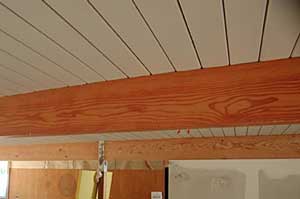Eichler Beam Restoration
 Consider the Eichler beam: an essential structural element that also adds grace and beauty to the mid-century modern design. One might assume that beams need no care, and that they should stay the same color as the day they were first painted. Not necessarily!
Consider the Eichler beam: an essential structural element that also adds grace and beauty to the mid-century modern design. One might assume that beams need no care, and that they should stay the same color as the day they were first painted. Not necessarily!
In fact, any exposed beam definitely needs periodic attention. If neglected, a beam can eventually bring forth a repair bill costing thousands of dollars. When such cases are found, they usually suffer from conditions that were simply left 'out of sight, out of mind': on the top surface of beams exposed in the atrium and those extending beyond the eaves of the house.
Decades of weathering cause paint to wear away, leaving the exposed wood beam open to cracking and the insidious effects of what is commonly called 'dry rot.' Even though dry rot is a rather inaccurate term for this condition—the problem doesn't occur in totally dry wood—it causes various types of fungi to deteriorate the wood. These organisms cannot exist if the moisture content of the wood is below 20 percent.
Therefore, the way to control wood rot is to prevent water from contacting the surface of the wood. It is essential to regularly inspect exposed beams and check to make sure that the paint protecting them has not lost its integrity.
When inspecting exposed beams for rot, if soft crumbly areas are found, Ron Key of Key Construction & Design in Mountain View recommends probing the beam to determine the degree of deterioration. If dry rot has affected more than 25 percent of the wood's total thickness, Key recommends getting a qualified structural engineer to inspect the beam to determine if it is structurally sound.
If the damage is superficial, he recommends scraping out the damaged areas until healthy wood is exposed. After making sure the beam is thoroughly dry, patch it with Bondo, and even cap the beam with metal flashing. Key warns against using substances such as 'exterior spackle.' which won't last. At the very least, Key says, keep the beam painted on a regular basis.
A different problem sometimes observed in beams is warping. This may occur because the beam was cut from wood very close to the heart of the tree, or wasn't cured properly. "I've never seen a beam warp to the degree that it could result in a structural problem," Key states. Additional good news comes with knowing that Eichler used top quality Douglas fir beams (the wood grading system employed in the '50s was more stringent than that used today); and when properly cared for, his beams should last indefinitely.
The Eichler architectural style exposed the massive 4x10-inch beams; they are the 'bones' of the structure. Consequently, their appearance has a tremendous impact on the feel of the interior spaces, particularly in the open-plan living area of the house. Most Eichler ceilings were originally treated with a light-colored wash, and the beams were painted white, or a dark color like charcoal, deep brown, or dark green. This produced a pleasing contrast and emphasized the presence of the beams running through the structure.
Over the years, some homeowners have painted ceilings and beams white. This causes the beams to recede visually and lose their impact compared to the original design. In such cases, don't hesitate to consider restoring the beams to their original glory with a contrasting coat of suitably colored dark or light paint.
Perhaps the ultimate step towards a bold, new look is to strip the paint from the beam and expose the wood, leaving it 'au naturel.' In many cases, the Eichler's Douglas fir beams had a strikingly handsome grain; however, how good your grain will look won't be known until the paint actually has been removed.
 Architect K.C. Marcinik sandblasted the roof peak beam in her Palo Alto Eichler, leaving a rough, unfinished texture. A different approach to beam exposure, and one involving considerable effort, is achieved with chemical paint strippers, extensive sanding, and treatment with a stain and sealer. This can produce stunning results, as Raymond Paquin has demonstrated in his San Mateo Highlands home [shown above right]. Here's how Paquin did it.
Architect K.C. Marcinik sandblasted the roof peak beam in her Palo Alto Eichler, leaving a rough, unfinished texture. A different approach to beam exposure, and one involving considerable effort, is achieved with chemical paint strippers, extensive sanding, and treatment with a stain and sealer. This can produce stunning results, as Raymond Paquin has demonstrated in his San Mateo Highlands home [shown above right]. Here's how Paquin did it.
The 'Au Naturel' Eichler Beam — Step by Step (courtesy Raymond Paquin)
-
Seal off the work area with plastic sheeting, and protect the floor. Even with the sander connected directly to a shop vacuum for dust control, this is a messy process. To keep the sanding dust to a minimum, he used a Fein (German-made) shop vac connected to the sanders. It has an 'auto-on' feature that starts and stops it automatically with the sander. Also, tape around and to the edges of the beams to be stripped.




